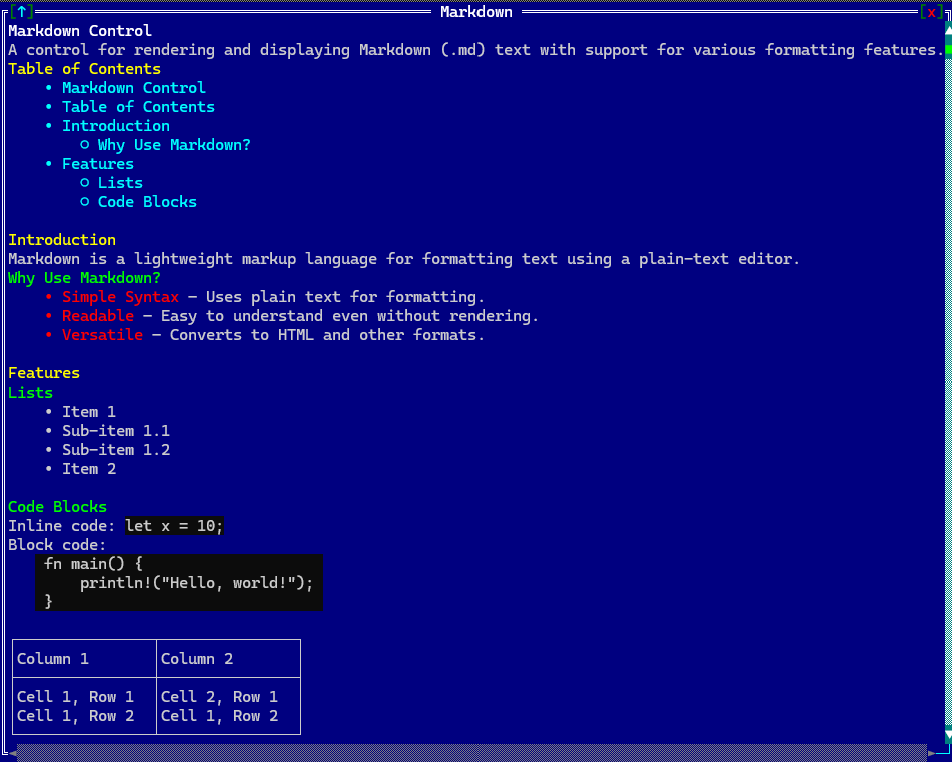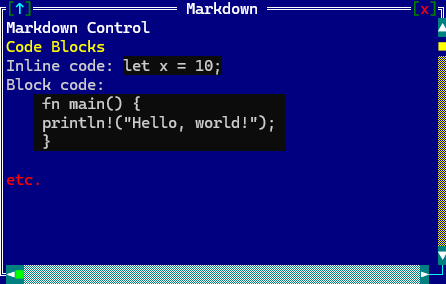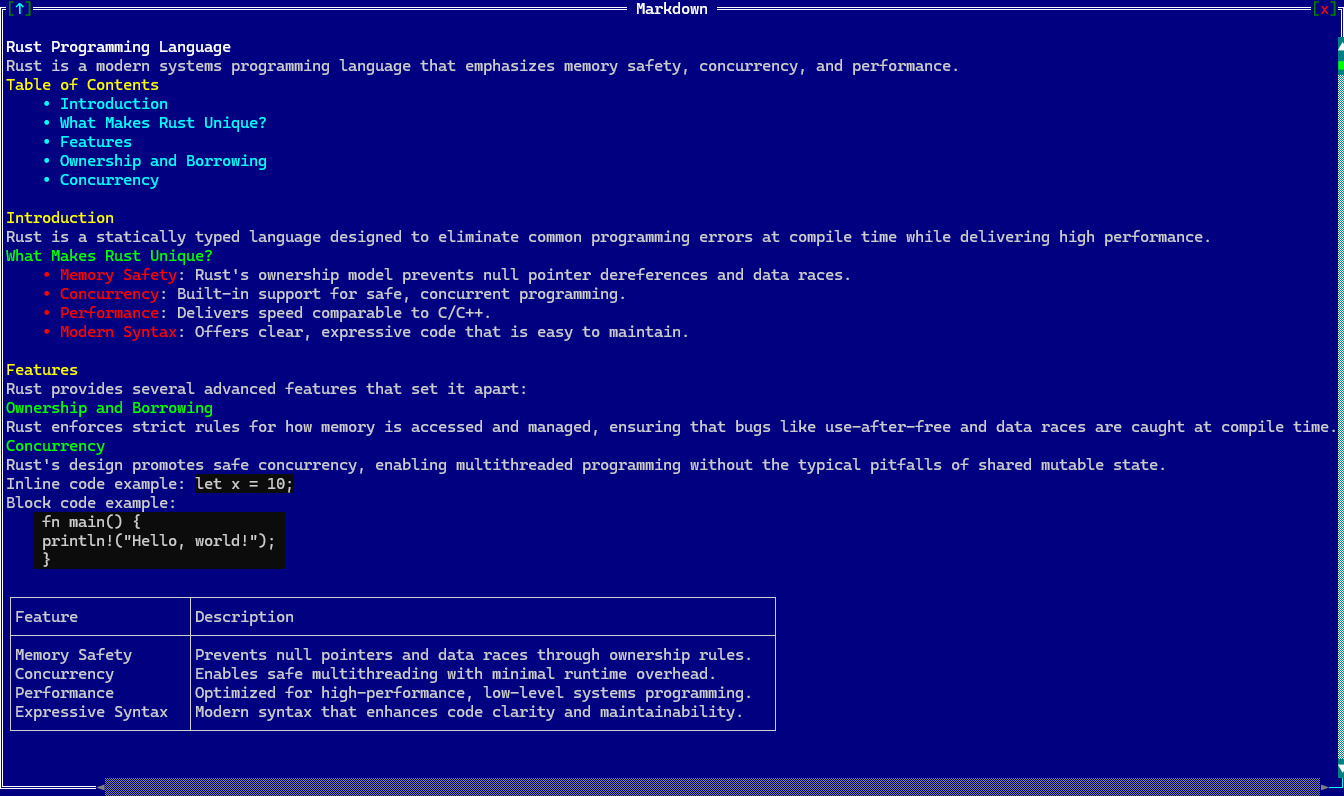Markdown
Represent a control that can properly display .md (Markdown) text.

To create a canvas use Markdown::new method (with 3 parameters: content, layout and initialization flags).
let m = Markdown::new(&content,layout!("d: c"),markdown::Flags::ScrollBars);
or the macro canvas!
let mut m = markdown!(
"'\r\n\
# Markdown Control\r\n\r\n\
## Code Blocks \r\n\r\n\
Inline code: `let x = 10;`\r\n\r\n\
Block code:\r\n\r\n\
```\r\n\
fn main() {\r\n\
println!(\"Hello, world!\");\r\n\
}\r\n\
```\r\n\r\n\
**etc.**\r\n',
d: c,
flags: ScrollBars"
);

A markdown control supports all common parameters (as they are described in Instantiate via Macros section). Besides them, the following named parameters are also accepted:
| Parameter name | Type | Positional parameter | Purpose |
|---|---|---|---|
content or text | String | Yes (first positional parameter) | The content of the markdown control |
flags | Flags | No | Canvas initialization flags |
left-scroll-margin or lsm | Integer | No | Defines the left margin of the bottom scroll bar in characters. If not provided, the default value is 0. Only applies if ScrollBars is set. |
top-scroll-margin or tsm | Integer | No | Defines the top margin of the right scroll bar in characters. If not provided, the default value is 0. Only applies if ScrollBars is set. |
A markdown supports the following initialization flags:
markdown::Flags::ScrollBarsorScrollBars(for macro initialization) - thils enable a set of scrollbars that can be used to change the view of the inner surface, but only when the control has focus, as described in Components section.
Some examples that uses these paramateres:
- A markdown control with two headers, inline code, a code block and the text
etc.marcked as bold.let mut m = markdown!( "'\r\n\ # Markdown Control\r\n\r\n\ ## Code Blocks \r\n\r\n\ Inline code: `let x = 10;`\r\n\r\n\ Block code:\r\n\r\n\ ```\r\n\ fn main() {\r\n\ println!(\"Hello, world!\");\r\n\ }\r\n\ ```\r\n\r\n\ **etc.**\r\n', d: c, flags: ScrollBars" ); - A markdown control containging a table and having scrollbars with different margins.
let mut m = markdown!( "'\r\n\ # Markdown Control\r\n\r\n\ | Column 1 | Column 2|\r\n\ | - | --- |\r\n\ | Cell 1, Row 1| Cell 2, Row 1 |\r\n\ | Cell 1, Row 2 | Cell 1, Row 2 |\r\n\ ', d: c, flags: ScrollBars, lsm:10,tsm:1" );
Events
To intercept events from a markdown control, the following trait has to be implemented to the Window that processes the event loop:
pub trait MarkdownEvents {
fn on_external_link(&mut self, markdown: Handle<Markdown>, link: &str) ->
EventProcessStatus {...}
}
Methods
Besides the Common methods for all Controls a canvas also has the following aditional methods:
| Method | Purpose |
|---|---|
set_content(...) | Replaces the canvas content with new data. It resets the drawing coordinates (x, y) and re-parses the content. |
Key association
The following keys are processed by a markdown control if it has focus:
| Key | Purpose |
|---|---|
Left,Right,Up,Down | Move the view port to a specified direction by one character. |
Example
The following code uses a markdown control to create a documentation viewer for the Rust programming language:
use appcui::prelude::*;
fn main() -> Result<(), appcui::system::Error> {
let mut a = App::new().build()?;
let mut w = window!("Markdown,a:c,w:50,h:15,flags:sizeable");
let m = markdown!(
"'''
\r\n\
# Rust Programming Language\r\n\
\r\n\
Rust is a modern systems programming language that emphasizes memory safety, concurrency, and performance.\r\n\
\r\n\
## Table of Contents\r\n\
- [Introduction](#introduction)\r\n\
- [What Makes Rust Unique?](#what-makes-rust-unique)\r\n\
- [Features](#features)\r\n\
- [Ownership and Borrowing](#ownership-and-borrowing)\r\n\
- [Concurrency](#concurrency)\r\n\
\r\n\
## Introduction\r\n\
\r\n\
Rust is a statically typed language designed to eliminate common programming errors at compile time while delivering high performance.\r\n\
\r\n\
### What Makes Rust Unique?\r\n\
\r\n\
- **Memory Safety**: Rust's ownership model prevents null pointer dereferences and data races.\r\n\
- **Concurrency**: Built-in support for safe, concurrent programming.\r\n\
- **Performance**: Delivers speed comparable to C/C++.\r\n\
- **Modern Syntax**: Offers clear, expressive code that is easy to maintain.\r\n\
\r\n\
## Features\r\n\
\r\n\
Rust provides several advanced features that set it apart:\r\n\
\r\n\
### Ownership and Borrowing\r\n\
\r\n\
Rust enforces strict rules for how memory is accessed and managed, ensuring that bugs like use-after-free and data races are caught at compile time.\r\n\
\r\n\
### Concurrency\r\n\
\r\n\
Rust's design promotes safe concurrency, enabling multithreaded programming without the typical pitfalls of shared mutable state.\r\n\
\r\n\
Inline code example: `let x = 10;`\r\n\
\r\n\
Block code example:\r\n\
\r\n\
```\r\n\
fn main() {\r\n\
println!(\"Hello, world!\");\r\n\
}\r\n\
```\r\n\
\r\n\
| Feature | Description |\r\n\
| ----------------- | -------------------------------------------------------------------- |\r\n\
| Memory Safety | Prevents null pointers and data races through ownership rules. |\r\n\
| Concurrency | Enables safe multithreading with minimal runtime overhead. |\r\n\
| Performance | Optimized for high-performance, low-level systems programming. |\r\n\
| Expressive Syntax | Modern syntax that enhances code clarity and maintainability. |\r\n\
''',d: c,flags: ScrollBars,lsm:10,tsm:1"
);
w.add(m);
a.add_window(w);
a.run();
Ok(())
}
